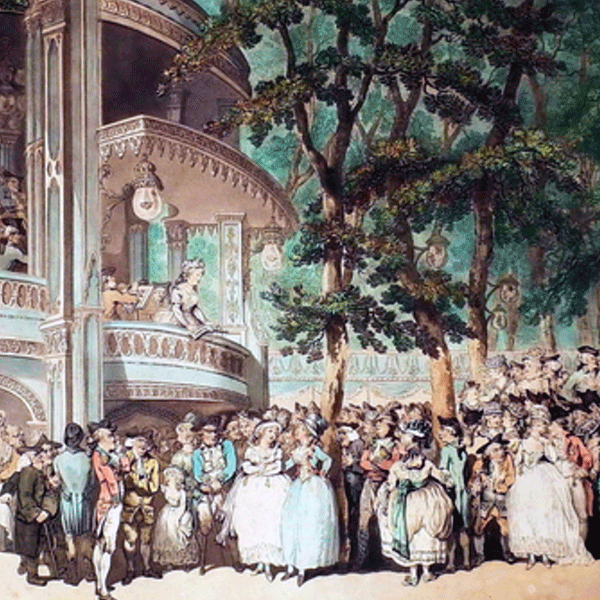
Sydney Gardens, Bath
I join with you in wishing for the environs of Laura Place, but do not venture to expect it. My mother hankers after the Square dreadfully, and it is but natural to suppose that my uncle will take her part. It would be very pleasant to be near Sydney Gardens; we might go into the labyrinth every day. -Jane Austen to Cassandra, January 21, 1801
Sydney Gardens is the oldest park in the City of Bath. Planned and laid out by the architect Harcourt Masters in 1795, it quickly became a popular place to see and be seen by the ever arriving crowds of fashionable people visiting the city. In 1909, Sydney Gardens were purchased by the City of Bath and in the same year, a replica Temple of Minerva was built to commemorate the Bath Historical Pageant.  One could reach the grounds via the Sydney Hotel, located in Sydney Place, at the end of Great Pultney Street. In 1801, the Austens, who were newly arrived in Bath, took lodgings at Number 4, Sydney Place, directly opposite Sydney Gardens. In describing their location to her sister Cassandra, Jane jokingly wrote, 'There is a public breakfast in Sydney Gardens every morning, so we shall not be wholly starved.' The public breakfast was one of several attractions Sydney Gardens had to offer visitors. Small orchestras performed on the balcony overlooking the grounds, and dining boxes, "a series of little shelters where private groups could take refreshments throughout the day" extended on either side of the main building.
One could reach the grounds via the Sydney Hotel, located in Sydney Place, at the end of Great Pultney Street. In 1801, the Austens, who were newly arrived in Bath, took lodgings at Number 4, Sydney Place, directly opposite Sydney Gardens. In describing their location to her sister Cassandra, Jane jokingly wrote, 'There is a public breakfast in Sydney Gardens every morning, so we shall not be wholly starved.' The public breakfast was one of several attractions Sydney Gardens had to offer visitors. Small orchestras performed on the balcony overlooking the grounds, and dining boxes, "a series of little shelters where private groups could take refreshments throughout the day" extended on either side of the main building.  In 1800, the Kennet and Avon Canal was dug through the gardens, despite strong opposition. Built between 1796 and 1810, the canal connected the Avon at Bath with the Kennet at Newbury, becoming a part of the major waterway connecting Bristol with London. In a sad twist of fate, the canal system was finished just years before steam engines, a faster and more efficient way of powering water transportation, made their way across Britain, making the canals virtually obsolete. It soon became used by lay travellers and sightseers only. The engineer of the canals, John Rennie, designed most of the elegant iron bridges in the park. Fortunately, the canal actually enhanced the charm of the gardens, for being "sunk low between stone embankments" it was "invisible from the gardens until the visitor passed over a bridge or came upon a balustrade when they would be surprised by the winding expanse of water with its overhanging trees and pretty bridges."
In 1800, the Kennet and Avon Canal was dug through the gardens, despite strong opposition. Built between 1796 and 1810, the canal connected the Avon at Bath with the Kennet at Newbury, becoming a part of the major waterway connecting Bristol with London. In a sad twist of fate, the canal system was finished just years before steam engines, a faster and more efficient way of powering water transportation, made their way across Britain, making the canals virtually obsolete. It soon became used by lay travellers and sightseers only. The engineer of the canals, John Rennie, designed most of the elegant iron bridges in the park. Fortunately, the canal actually enhanced the charm of the gardens, for being "sunk low between stone embankments" it was "invisible from the gardens until the visitor passed over a bridge or came upon a balustrade when they would be surprised by the winding expanse of water with its overhanging trees and pretty bridges."
There is to be a grand gala on Tuesday evening in Sydney Gardens, a concert, with illuminations and fireworks. To the latter Elizabeth and I look forward with pleasure, and even the concert will have more than its usual charm for me, as the gardens are large enough for me to get pretty well beyond the reach of its sound. -Jane to Cassandra, June 2, 1799
The Austens moved from Sydney Place to lodgings in Green Park Buildings in 1804. Shortly after that the Rev. Austen, Jane's father, sadly passed away and the family left Bath for good in 1806. Despite leaving, Bath would feature prominently in two of Jane's future novels. Her time in Bath was no doubt spent absorbing the sights, sounds and feel of the city, leaving a permanent record for generations to come. In 1819, Pierce Egan published his Walks Through Bath which included the following description of the gardens and walks Jane would have been familiar with.
Sydney Gardens - from Walks Through Bath
The Entrance to Sydney Tavern and Gardens has to boast of much respectability; and the tavern is a capacious and elegant erection. Sydney-Gardens is one of the most prominent, pleasing, and elegant features attached to the City of Bath.  The hand of taste is visible in every direction of it; and the plants and trees exhibit the most beautiful luxuriance. Upon gala-nights, the music, singing, cascades, transparencies, fire-works, and superb illuminations, render these gardens very similar to Vauxhall. The Orchestra is close to the back of the Tavern, neatly arranged and elevated, with a large open space before it, well gravelled. The gradual ascent of the principal walk, that leads to the top of the gardens up to a half-circular stone pavillion, which is paved and covered in, with a seat round it, and supported by several stone pillars, upon a gala-night has a most brilliant effect, from the numerous variegated lamps with which it is ornamented. The walks are all well rolled and gravelled; and seats and places for refreshment are to be met with in various parts of the gardens.
The hand of taste is visible in every direction of it; and the plants and trees exhibit the most beautiful luxuriance. Upon gala-nights, the music, singing, cascades, transparencies, fire-works, and superb illuminations, render these gardens very similar to Vauxhall. The Orchestra is close to the back of the Tavern, neatly arranged and elevated, with a large open space before it, well gravelled. The gradual ascent of the principal walk, that leads to the top of the gardens up to a half-circular stone pavillion, which is paved and covered in, with a seat round it, and supported by several stone pillars, upon a gala-night has a most brilliant effect, from the numerous variegated lamps with which it is ornamented. The walks are all well rolled and gravelled; and seats and places for refreshment are to be met with in various parts of the gardens.
The view, when seated in the above pavillion down to the orchestra, across the arches covered with lamps, gives it a very captivating appearance. Upon those nights set apart for promenading only, a military band attends; and music also enlivens the scene, when public breakfasts are given. There are also several swings, adapted for the ladies; and others for gentlemen. Numerous covered-in boxes; and several alcoves formed with much botanical taste, grottos, &c. render this promenade highly attractive during the summer evenings. In the most retired parts of the gardens one of these grottos, it appears, was once the happy meeting-place, and dedicated to the tender passion, with a sincerity and animation unrivalled, by one of the greatest geniuses that ever adorned this or any other country, but who is gone to that “bourne from whence no traveller returns,” following the superior, amiable, and affectionate object of his heart, who had also long been previously consigned to the icy tomb of death.
Upon the whole, Sydney-Gardens must be viewed not only as a great ornament to Bath, but is another, among the numerous proofs of the great anxiety of the inhabitants to render the amusements of this elegant City, without a parallel in the kingdom! The Kennet and Avon Canal runs through the gardens, with two elegant cast-iron bridges thrown over it, after the manner of the Chinese; and the romantic and picturesque scenery, by which they are surrounded, is fascinating beyond measure. Great opposition, it seems, was originally made to the canal running through these gardens by the proprietor; but it gives such a variety to the walks, that its introduction is now viewed as a great addition. It would be a matter of some difficulty to point out a spot of ground so tastefully laid out as Sydney-Gardens. Vauxhall, it is true, may boast of its superiority for brilliancy, and number of lamps, and vocal performers; but, in other respects, viewed as a garden, the competition would be perfectly ridiculous.
The Labyrinth, shown here at three-pence each person, is an object of curiosity. The inducement to enter it is one of Merlin’s swings, which appears not only very prominent, but easy of access. However, it might puzzle any cunning person, if left to himself and without a clue, for six hours, to acquire the much wished for spot; and it is rather a difficult task when the explorer of the Labyrinth has the direction pointed out to him from a man stationed in the swing. The inns and outs necessary to be made, it is said, measure half a mile. When the swing is made, and the secret unravelled, the guardian of this sort of Fair Rosamond’s bower conveys the visitor once more into the public walks; the variety of which, that continually meet the eye of the promenader are truly attractive. A most delightful piece of ground, like a bowling green, enveloped with trees, and a small natural cascade from a spring, cannot be passed with indifference.
The company, generally, are of the most respectable description; and upon some of the gala-nights, upwards of 4000 persons have paid for admission, which is 2s. 6d. each. In fact, the most fastidious observer cannot find fault with Sydney-Gardens, which have also another advantage to recommend them to the visitors of Bath, namely, in having a surrounding ride, for the accommodation of ladies and gentlemen on horseback, that commands beautiful and romantic views, and of being free from dust in the summer, and dirt in the winter. The terms of subscription for walking are for one month, each person, 4s.; for 3 months, 7s. 6d.; and the season, 10s. If two in one family, each 7s 6d; if three or more, each 6s. Non-subscribers, for walking, 6d. each time. Nursery-maids with children in arms, one subscription. Gentlemen and families may be accommodated with elegant apartments at Sydney-House. The terms of subscription to the ride, one month, 2s. 6d. each person. Three months, 6s. Six months, 10s. The year, 15s. Non-subscribers, 6d. each time.
The majority of historical information is from The Holburne Museum of Art, Bath. The Holburne Museum owns the orignal prints of Sydney Gardens by J. G. Nattes, painted in 1806 and reproduced in this article.
If you don't want to miss a beat when it comes to Jane Austen, make sure you are signed up to the Jane Austen newsletter for exclusive updates and discounts from our Online Gift Shop.



Leave a comment
This site is protected by reCAPTCHA and the Google Privacy Policy and Terms of Service apply.